Analysis of Cultivated Land Productivity in Southern China: Stability and Drivers
Abstract
1. Introduction
2. Materials and Methods
2.1. Study Area
2.2. Data Sources and Processing
2.3. Research Methodology
2.3.1. Theil–Sen Median Trend Analysis and Mann–Kendall Significance Test
2.3.2. Stability Analysis of Cultivated Land Productivity
2.3.3. Cultivated Land Landscape Pattern Metrics
2.3.4. Analysis of Factors Influencing the Stability of Cultivated Land Productivity
2.3.5. Methodological Flowchart for the Stability of Cultivated Land Productivity
3. Results
3.1. Spatiotemporal Change Characteristics of Regional Cultivated Land Utilization
3.2. Spatiotemporal Changes in NPP in Long-Term Cultivated Land
3.3. Spatial Distribution of Cultivated Land Productivity Stability from 2001 to 2022
3.4. Factors Affecting the Stability of Cultivated Land Productivity from 2001 to 2022
4. Discussion
4.1. Cultivated Land NPP Stability: A Core Indicator of System Resilience
4.2. Spatial Change in Cultivated Land Affect the Stability of Regional Cultivated Land Productivity
4.3. Climate Change and Cropping Systems’ Influence on the Stability of Cultivated Land Productivity
4.4. Technological Progress Influence on the Growth of Cultivated Land Productivity
4.5. Study Limitations and Prospects
5. Conclusions
Supplementary Materials
Author Contributions
Funding
Data Availability Statement
Acknowledgments
Conflicts of Interest
References
- UN General Assembly. Transforming Our World: The 2030 Agenda for Sustainable Development: Resolution; UN: New York, NY, USA, 2015. [Google Scholar]
- Long, H.L.; Kong, X.B.; Hu, S.G.; Li, Y.R. Land Use Transitions under Rapid Urbanization: A Perspective from Developing China. Land 2021, 10, 935. [Google Scholar] [CrossRef]
- Wang, X. Changes in cultivated land loss and landscape fragmentation in China from 2000 to 2020. Land 2022, 11, 684. [Google Scholar] [CrossRef]
- Lesk, C.; Rowhani, P.; Ramankutty, N. Influence of extreme weather disasters on global crop production. Nature 2016, 529, 84–87. [Google Scholar] [CrossRef] [PubMed]
- Chaudhuri, S.; Roy, M.; McDonald, L.M.; Emendack, Y. Land Degradation—Desertification in Relation to Farming Practices in India: An Overview of Current Practices and Agro-Policy Perspectives. Sustainability 2023, 15, 6383. [Google Scholar] [CrossRef]
- Meng, L.; Huang, C.; Chen, X.; Jiang, L.; Zhang, G.; Hao, J.; An, P. Evaluation of cultivated land system resilience of Quzhou County. Resour. Sci. 2019, 41, 1949–1958. [Google Scholar] [CrossRef]
- Domínguez-García, V.; Dakos, V.; Kéfi, S. Unveiling dimensions of stability in complex ecological networks. Proc. Natl. Acad. Sci. USA 2019, 116, 25714–25720. [Google Scholar] [CrossRef]
- Huang, G.X.; Wang, P. Assessment of the ecosystem stability of Shapotou arid desert nature reserve in Ningxia, China. Acta Ecol. Sin. 2019, 39, 6381–6392. [Google Scholar] [CrossRef]
- Tian, S.; Zhu, B.; Yin, R.; Wang, M.; Jiang, Y.; Zhang, C.; Li, D.; Chen, X.; Kardol, P.; Liu, M. Organic fertilization promotes crop productivity through changes in soil aggregation. Soil Biol. Biochem. 2022, 165, 108533. [Google Scholar] [CrossRef]
- Ding, W.; Song, D.; Zhou, W. Dominant factors driving the farmland quality in China and strategies for improvement. J. Plant Nutr. Fertil. 2024, 30, 1580–1594. [Google Scholar] [CrossRef]
- Li, S.; Wu, X.; Song, X.; Liu, X.; Gao, H.; Liang, G.; Zhang, M.; Zheng, F.; Yang, P. Long-term nitrogen fertilization enhances crop yield potential in no-tillage systems through enhancing soil fertility. Resour. Conserv. Recycl. 2024, 206, 107622. [Google Scholar] [CrossRef]
- Allocca, C.; Castrignanò, A.; Nasta, P.; Romano, N. Regional-scale assessment of soil functions and resilience indicators: Accounting for change of support to estimate primary soil properties and their uncertainty. Geoderma 2023, 431, 116339. [Google Scholar] [CrossRef]
- Dubovyk, O. The role of Remote Sensing in land degradation assessments: Opportunities and challenges. Eur. J. Remote Sens. 2017, 50, 601–613. [Google Scholar] [CrossRef]
- Liao, C.; Wang, J.; Dong, T.; Shang, J.; Liu, J.; Song, Y. Using spatio-temporal fusion of Landsat-8 and MODIS data to derive phenology, biomass and yield estimates for corn and soybean. Sci. Total Environ. 2019, 650, 1707–1721. [Google Scholar] [CrossRef] [PubMed]
- Wang, J.; Li, X.; Lu, L.; Fang, F. Estimating near future regional corn yields by integrating multi-source observations into a crop growth model. Eur. J. Agron. 2013, 49, 126–140. [Google Scholar] [CrossRef]
- Xu, W.; Jin, J.; Jin, X.; Xiao, Y.; Ren, J.; Liu, J.; Sun, R.; Zhou, Y. Analysis of changes and potential characteristics of cultivated land productivity based on MODIS EVI: A case study of Jiangsu Province, China. Remote Sens. 2019, 11, 2041. [Google Scholar] [CrossRef]
- Liu, K.; Li, X.; Wang, S.; Zhou, G. Past and future adverse response of terrestrial water storages to increased vegetation growth in drylands. Npj Clim. Atmos. Sci. 2023, 6, 113. [Google Scholar] [CrossRef]
- Zhou, W.; Li, C.; Fu, B.; Wang, S.; Ren, Z.; Stringer, L.C. Changes and drivers of vegetation productivity in China’s drylands under climate change. Environ. Res. Lett. 2024, 19, 114001. [Google Scholar] [CrossRef]
- Chen, J.; Chi, Y.; Zhou, W.; Wang, Y.; Zhuang, J.; Zhao, N.; Ding, J.; Song, J.; Zhou, L. Quantifying the Dimensionalities and Drivers of Ecosystem Stability at Global Scale. J. Geophys. Res. Biogeosci. 2021, 126, e2020JG006041. [Google Scholar] [CrossRef]
- Han, B.; Jin, X.; Yeting, F.; Chen, H.; Jin, J.; Xu, W.; Ren, J.; Zhou, Y. Trend and spatial pattern of stable cropland productivity in China based on satellite observations (2001−2020). Environ. Impact Asses. 2023, 101, 107136. [Google Scholar] [CrossRef]
- Piao, S.; Ciais, P.; Huang, Y.; Shen, Z.; Peng, S.; Li, J.; Zhou, L.; Liu, H.; Ma, Y.; Ding, Y.; et al. The impacts of climate change on water resources and agriculture in China. Nature 2010, 467, 43–51. [Google Scholar] [CrossRef]
- Yang, Y.; Tilman, D.; Jin, Z.; Smith, P.; Barrett, C.B.; Zhu, Y.; Burney, J.; D’Odorico, P.; Fantke, P.; Fargione, J.; et al. Climate change exacerbates the environmental impacts of agriculture. Science 2024, 385, eadn3747. [Google Scholar] [CrossRef] [PubMed]
- Liu, Y.; Liu, L.; Zhu, A.; Lao, C.; Hu, G.; Hu, Y. Scenario farmland protection zoning based on production potential: A case study in China. Land Use Policy 2020, 95, 104581. [Google Scholar] [CrossRef]
- Ye, S.; Ren, S.; Song, C.; Cheng, C.; Shen, S.; Yang, J.; Zhu, D. Spatial patterns of county-level arable land productive-capacity and its coordination with land-use intensity in mainland China. Agric. Ecosyst. Environ. 2022, 326, 107757. [Google Scholar] [CrossRef]
- Wang, X.; Feng, Q.; Li, B.; Fan, Y.; Fan, H.; Yang, N.; Quan, Y.; Ding, H.; Zhang, Y. Trends and Factors Influencing the Evolution of Spatial Patterns of Cropland toward Large-Scale Agricultural Production in China. Land 2024, 13, 607. [Google Scholar] [CrossRef]
- Zhou, X.; Liang, Y.; Li, X.; Chai, D. The spatiotemporal evolution and driving factors of farmland system health: Taking the middle and lower reaches of the Yangtze River as an example. J. Nat. Resour. 2024, 39, 1174–1192. [Google Scholar] [CrossRef]
- Bren D Amour, C.; Reitsma, F.; Baiocchi, G.; Barthel, S.; Güneralp, B.; Erb, K.; Haberl, H.; Creutzig, F.; Seto, K.C. Future urban land expansion and implications for global croplands. Proc. Natl. Acad. Sci. USA 2017, 114, 8939–8944. [Google Scholar] [CrossRef]
- Tu, Y.; Chen, B.; Yu, L.; Song, Y.; Wu, S.; Li, M.; Wei, H.; Chen, T.; Lang, W.; Gong, P.; et al. Raveling the nexus between urban expansion and cropland loss in China. Landsc. Ecol. 2023, 38, 1869–1884. [Google Scholar] [CrossRef]
- Liu, J.; Jin, X.; Xu, W.; Zhou, Y. Evolution of cultivated land fragmentation and its driving mechanism in rural development: A case study of Jiangsu Province. J. Rural Stud. 2022, 91, 58–72. [Google Scholar] [CrossRef]
- Liu, J.; Jin, X.; Xu, W.; Wang, S.; Zhou, Y. Characteristic evolution and trend prediction of cultivated land landscape fragmentation in China from 1990 to 2020. Acta Geogr. Sin. 2023, 78, 2163–2185. [Google Scholar] [CrossRef]
- Kuang, W.; Liu, J.; Tian, H.; Shi, H.; Dong, J.; Song, C.; Li, X.; Du, G.; Hou, Y.; Lu, D.; et al. Cropland redistribution to marginal lands undermines environmental sustainability. Natl. Sci. Rev. 2022, 9, nwab091. [Google Scholar] [CrossRef]
- Su, Y.; Qian, K.; Lin, L.; Wang, K.; Guan, T.; Gan, M. Identifying the driving forces of non-grain production expansion in rural China and its implications for policies on cultivated land protection. Land Use Policy 2020, 92, 104435. [Google Scholar] [CrossRef]
- Fan, J.; Wang, L.; Qin, J.; Zhang, F.; Xu, Y. Evaluating cultivated land stability during the growing season based on precipitation in the Horqin Sandy Land, China. J. Environ. Manag. 2020, 276, 111269. [Google Scholar] [CrossRef] [PubMed]
- Xiao, Q.; Wang, Y. Spatial-temporal Differentiation Characteristics and Influencing Factors of Cultivated Land NPP in Major Grain Producing Areas (Henan Province). Environ. Sci. 2024, 1–15. [Google Scholar] [CrossRef]
- Hamed, K.H.; Ramachandra Rao, A. A modified Mann-Kendall trend test for autocorrelated data. J. Hydrol. 1998, 204, 182–196. [Google Scholar] [CrossRef]
- Li, J.H.; Zhou, K.C.; Dong, H.M.; Xie, B.G. Cultivated Land Change, Driving Forces and Its Impact on Landscape Pattern Changes in the Dongting Lake Basin. Int. J. Environ. Res. Public Health 2020, 17, 7988. [Google Scholar] [CrossRef] [PubMed]
- Yu, Z.H.; Kuang, L.H.; Jiang, Y.F.; Li, W.F.; Zhang, J.; Zhou, Y.T.; Guo, X.; Ye, Y.C. Soil attributes are more important than others in shaping the diversity of cultivated land quality types, southern China. Ecol. Indic. 2024, 166, 112472. [Google Scholar] [CrossRef]
- McGarigal, K. FRAGSTATS Help; University of Massachusetts: Amherst, MA, USA, 2015; 182p. [Google Scholar]
- Wang, X.; Xu, H.; Pan, C. Change Features of Cultivated Land Resources and Its Driving Factors in Tarim River Basin. Bull. Soil Water Conserv. 2017, 37, 327–332. [Google Scholar] [CrossRef]
- Yao, Y.; Liu, Y.; Fu, F.; Song, J.; Wang, Y.; Han, Y.; Wu, T.; Fu, B. Declined terrestrial ecosystem resilience. Glob. Change Biol. 2024, 30, e17291. [Google Scholar] [CrossRef]
- Lyu, X.; Wang, Y.; Niu, S.; Peng, W. Spatio-Temporal Pattern and Influence Mechanism of Cultivated Land System Resilience: Case from China. Land 2022, 11, 11. [Google Scholar] [CrossRef]
- Jia, L.; Yu, K.; Li, Z.; Li, P.; Xu, G.; Cong, P.; Li, B. Spatiotemporal pattern of NPP and its response to climatic factors in the Yangtze River Economic Belt. Ecol. Indic. 2024, 162, 112017. [Google Scholar] [CrossRef]
- De Keersmaecker, W.; Lhermitte, S.; Honnay, O.; Farifteh, J.; Somers, B.; Coppin, P. How to measure ecosystem stability? An evaluation of the reliability of stability metrics based on remote sensing time series across the major global ecosystems. Glob. Change Biol. 2014, 20, 2149–2161. [Google Scholar] [CrossRef] [PubMed]
- Zhang, S.; Hao, X.M.; Zhao, Z.; Zhang, J.; Fan, X.; Li, X. Natural Vegetation Succession Under Climate Change and the Combined Effects on Net Primary Productivity. Earth’s Future 2023, 11, e2023EF003903. [Google Scholar] [CrossRef]
- Yu, Q.; Yue, D.P.; Wang, Y.H.; Kai, S.; Fang, M.Z.; Ma, H.; Zhang, Q.B.; Huang, Y. Optimization of ecological node layout and stability analysis of ecological network in desert oasis: A typical case study of ecological fragile zone located at Deng Kou County (Inner Mongolia). Ecol. Indic. 2018, 84, 304–318. [Google Scholar] [CrossRef]
- Yan, Y.; Guan, Q.Y.; Shao, W.Y.; Wang, Q.Z.; Yang, X.Y.; Luo, H.P. Spatiotemporal dynamics and driving mechanism of arable ecosystem stability in arid and semi-arid areas based on Pressure-Buffer-Response process. J. Clean. Prod. 2023, 421, 138553. [Google Scholar] [CrossRef]
- Gao, H.; Gong, J.; Ye, T.; Maier, M.; Liu, J. Constructing cropland ecological stability assessment method based on disturbance-resistance-response processes and classifying cropland ecological types. Sci. Total Environ. 2024, 930, 172673. [Google Scholar] [CrossRef]
- Lv, T.; Chen, A.; Fu, S.; Zhao, Q.; Liang, H. Spatial-temporal evolution characteristics and influencing mechanism of resilience of China’s cultivated land system under agricultural green transformation. Acta Ecol. Sin. 2025, 1–14. [Google Scholar] [CrossRef]
- Sun, X.; Cai, W.; Kong, X.; Li, Q.; Zhao, J. Quality regulation pattern and consolidation time zone of county-level cultivated land based on multi agent collaboration. Trans. Chin. Soc. Agric. Eng. 2023, 39, 232–245. [Google Scholar] [CrossRef]
- Wang, L.; Zhang, Q.; Zhang, Y.; Wei, X.; Zhao, A.; Zhang, X. Evaluating the Improved Ability of Irrigation Water Conservancy Engineering Projects Since 2011 in Mitigating Flood and Drought in China. J. Irrig. Drain. 2021, 40, 129–136. [Google Scholar] [CrossRef]
- Jin, W.; Ai, G.; Xiong, Y. The Impact of Environmental Changes on Agricultural Waterlogging Disasters: A case study of the Three Rivers Union in the Ganfu Plain Irrigation Area. Water Resour. Hydropower Eng. 2024, 94–101. [Google Scholar]
- Ma, L.; Long, H.; Tang, L.; Tu, S.; Zhang, Y.; Qu, Y. Analysis of the spatial variations of determinants of agricultural production efficiency in China. Comput. Electron. Agric. 2021, 180, 105890. [Google Scholar] [CrossRef]
- Zhang, S.; Chen, W.; Wang, Y.; Li, Q.; Shi, H.; Li, M.; Sun, Z.; Zhu, B.; Seyoum, G. Human interventions have enhanced the net ecosystem productivity of farmland in China. Nat. Commun. 2024, 15, 10523. [Google Scholar] [CrossRef] [PubMed]
- Ren, P.; Wu, T.; Zhou, J. Analysis of spatial distribution pattern and evolutionary characteristics of cultivated lands based on spatial autocorrelation model and GIS platform—A case study of Longquanyi District, Chengdu, China. Chin. J. Eco-Agric. 2016, 24, 325–334. [Google Scholar] [CrossRef]
- Hao, W.; Hu, X.; Wang, J.; Zhang, Z.; Shi, Z.; Zhou, H. The impact of farmland fragmentation in China on agricultural productivity. J. Clean. Prod. 2023, 425, 138962. [Google Scholar] [CrossRef]
- Potapov, P.; Turubanova, S.; Hansen, M.C.; Tyukavina, A.; Zalles, V.; Khan, A.; Song, X.; Pickens, A.; Shen, Q.; Cortez, J. Global maps of cropland extent and change show accelerated cropland expansion in the twenty-first century. Nat. Food. 2022, 3, 19–28. [Google Scholar] [CrossRef]
- Zhong, Y.; Shao, H.; Xu, C.; Zhu, Z. The Spatial-Temporal Evolution Analysis of Land Utilization and Landscape Pattern in Poyang Lake Area from 2001 to 2018. J. Jiangxi Norm. Univ. (Nat. Sci. Ed.) 2021, 45, 94–102. [Google Scholar] [CrossRef]
- Qing, L.; Huanhuan, F.; Fuqing, Z.; Wenbo, C.; Yuanping, X.; Bing, Y. The dominant role of human activity intensity in spatial pattern of ecosystem health in the Poyang Lake ecological economic zone. Ecol. Indic. 2024, 166, 112347. [Google Scholar] [CrossRef]
- Zhong, Y.; Sun, J.; Wang, Q.; Ou, D.; Tian, Z.; Yu, W.; Li, P.; Gao, X. Spatiotemporal Distribution and Driving Mechanisms of Cropland Long-Term Stability in China from 1990 to 2018. Land 2024, 13, 1016. [Google Scholar] [CrossRef]
- Gao, X.; Cheng, W.; Wang, N.; Liu, Q.; Ma, T.; Chen, Y.; Zhou, C. Spatio-temporal distribution and transformation of cropland in geomorphologic regions of China during 1990–2015. J. Geogr. Sci. 2019, 29, 180–196. [Google Scholar] [CrossRef]
- Qu, S.J.; Hu, S.G.; Li, W.D.; Wang, H.; Zhang, C.R.; Li, Q.F. Interaction between urban land expansion and land use policy: An analysis using the DPSIR framework. Land Use Policy 2020, 99, 104856. [Google Scholar] [CrossRef]
- Wu, X.; Zhao, N.; Wang, Y.; Zhang, L.; Wang, W.; Liu, Y. Cropland non-agriculturalization caused by the expansion of built-up areas in China during 1990–2020. Land Use Policy 2024, 146, 107312. [Google Scholar] [CrossRef]
- Liu, C.; Song, C.; Ye, S.; Cheng, F.; Zhang, L.; Li, C. Estimate provincial-level effectiveness of the arable land requisition-compensation balance policy in mainland China in the last 20 years. Land Use Policy 2023, 131, 106733. [Google Scholar] [CrossRef]
- Long, Y.Q.; Sun, J.; Wellens, J.; Colinet, G.; Wu, W.B.; Meersmans, J. Mapping the Spatiotemporal Dynamics of Cropland Abandonment and Recultivation across the Yangtze River Basin. Remote Sens. 2024, 16, 1052. [Google Scholar] [CrossRef]
- Wang, Y.; Aoxi, Y.; Xin, L.; Dong, S.; Li, X. Spatial and temporal differentiation and influencing factors of fallowing in different types of farmland in China: Based on survey data from 346 mountainous counties. Geogr. Res.-Aust. 2024, 43, 1977–1993. [Google Scholar] [CrossRef]
- Liu, X.Y.; Shi, H.D.; Bai, Z.K.; Liu, X.C.; Yang, B.; Yan, D.X. Assessing Soil Acidification of Croplands in the Poyang Lake Basin of China from 2012 to 2018. Sustainability 2020, 12, 3072. [Google Scholar] [CrossRef]
- Li, P.; Feng, Z.M.; Jiang, L.G.; Liu, Y.J.; Xiao, X.M. Changes in rice cropping systems in the Poyang Lake Region, China during 2004–2010. J. Geogr. Sci. 2012, 22, 653–668. [Google Scholar] [CrossRef]
- Yang, L.; Wang, L.; Chu, J.; Zhao, H.; Zhao, J.; Zang, H.; Yang, Y.; Zeng, Z. Improving soil quality and wheat yield through diversified crop rotations in the North China Plain. Soil Tillage Res. 2024, 244, 106231. [Google Scholar] [CrossRef]
- Jin, T.; Zhong, T. Changing rice cropping patterns and their impact on food security in southern China. Food Secur. 2022, 14, 907–917. [Google Scholar] [CrossRef]
- Wang, R.; Li, X.; Tan, M.; Xin, L.; Wang, X.; Wang, Y.; Jiang, M. Inter-provincial Differences in Rice Multi-cropping Changes in Main Double-cropping Rice Area in China: Evidence from Provinces and Households. Chin. Geogr. Sci. 2019, 29, 127–138. [Google Scholar] [CrossRef]
- Jiang, M.; Li, X.B.; Xin, L.J.; Tan, M.H. Paddy rice multiple cropping index changes in Southern China: Impacts on national grain production capacity and policy implications. J. Geogr. Sci. 2019, 29, 1773–1787. [Google Scholar] [CrossRef]
- Pan, Y.; Smith, S.C.; Sulaiman, M. Agricultural Extension and Technology Adoption for Food Security: Evidence from Uganda. Am. J. Agric. Econ. 2018, 100, 1012–1031. [Google Scholar] [CrossRef]
- Yu, K.; Zhao, S.; Sun, B.; Jiang, H.; Hu, L.; Xu, C.; Yang, M.; Han, X.; Chen, Q.; Qi, Z. Enhancing Food Production Through Modern Agricultural Technology. Plant Cell Environ. 2024. [Google Scholar] [CrossRef] [PubMed]
- Zhang, J.; Wang, J.; Chen, Y.; Huang, S.; Liang, B. Spatiotemporal variation and prediction of NPP in Beijing-Tianjin-Hebei region by coupling PLUS and CASA models. Ecol. Inf. 2024, 81, 102620. [Google Scholar] [CrossRef]
- Müller, C.; Jägermeyr, J.; Franke, J.A.; Ruane, A.C.; Balkovic, J.; Ciais, P.; Dury, M.; Falloon, P.; Folberth, C.; Hank, T. Substantial differences in crop yield sensitivities between models call for functionality-based model evaluation. Earth’s Future 2024, 12, e2023EF003773. [Google Scholar] [CrossRef]
- Li, Z.; Zhao, Y.; Taylor, J.; Gaulton, R.; Jin, X.; Song, X.; Li, Z.; Meng, Y.; Chen, P.; Feng, H. Comparison and transferability of thermal, temporal and phenological-based in-season predictions of above-ground biomass in wheat crops from proximal crop reflectance data. Remote Sens. Environ. 2022, 273, 112967. [Google Scholar] [CrossRef]


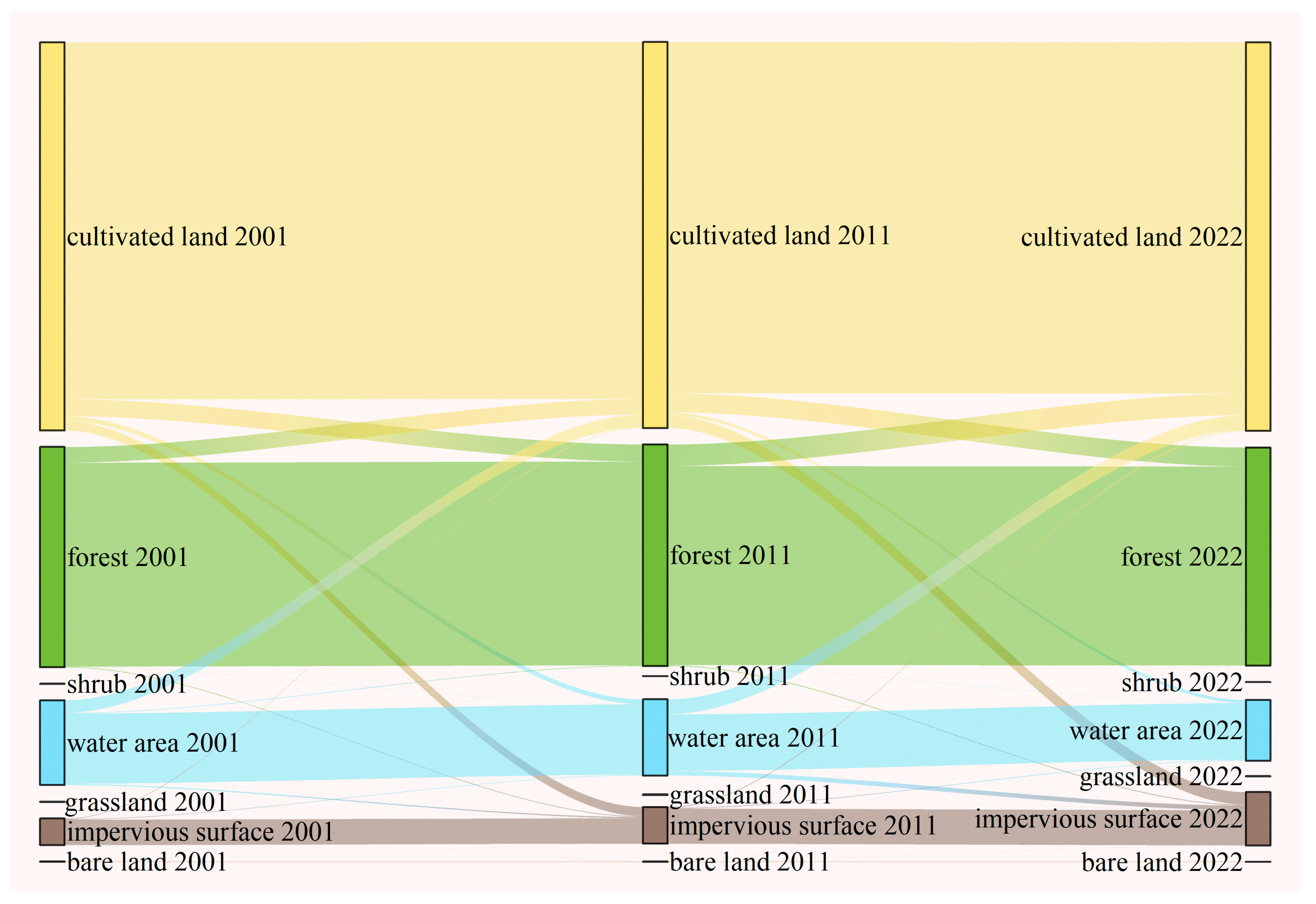
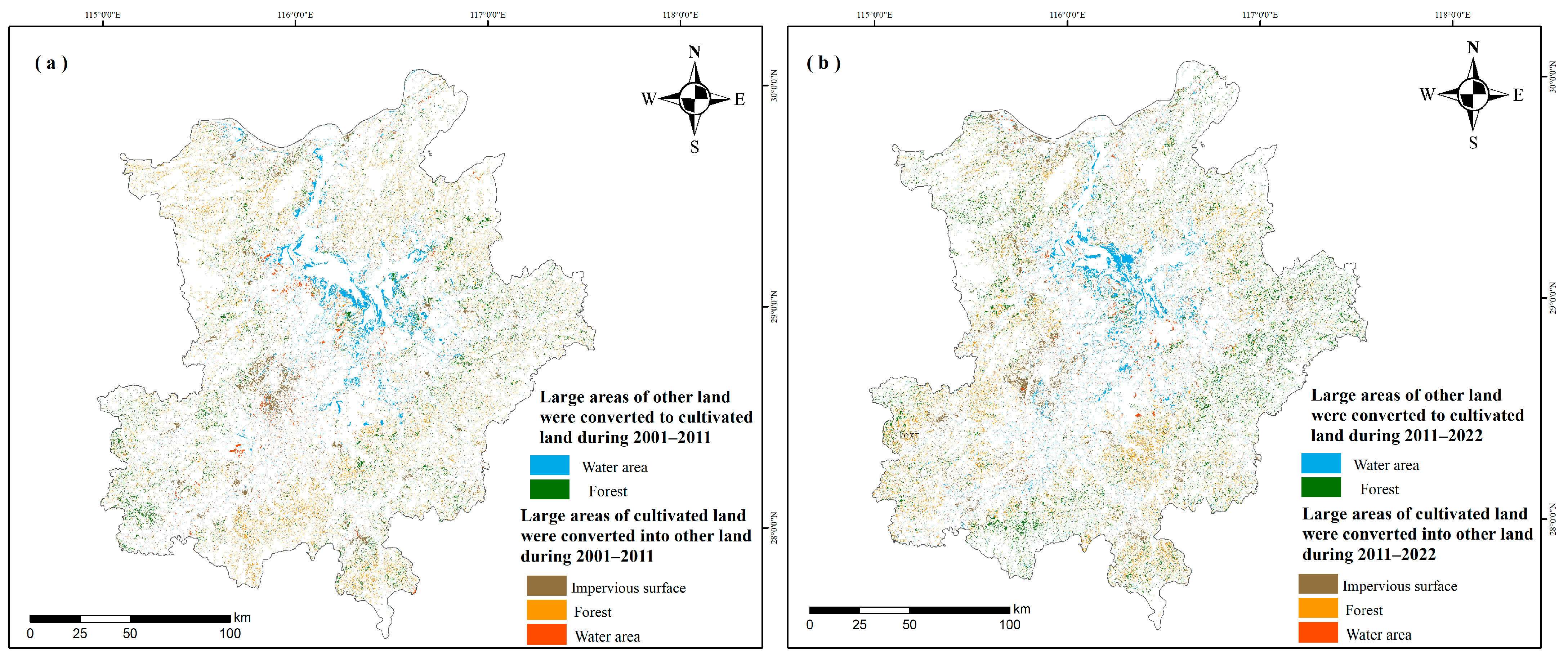
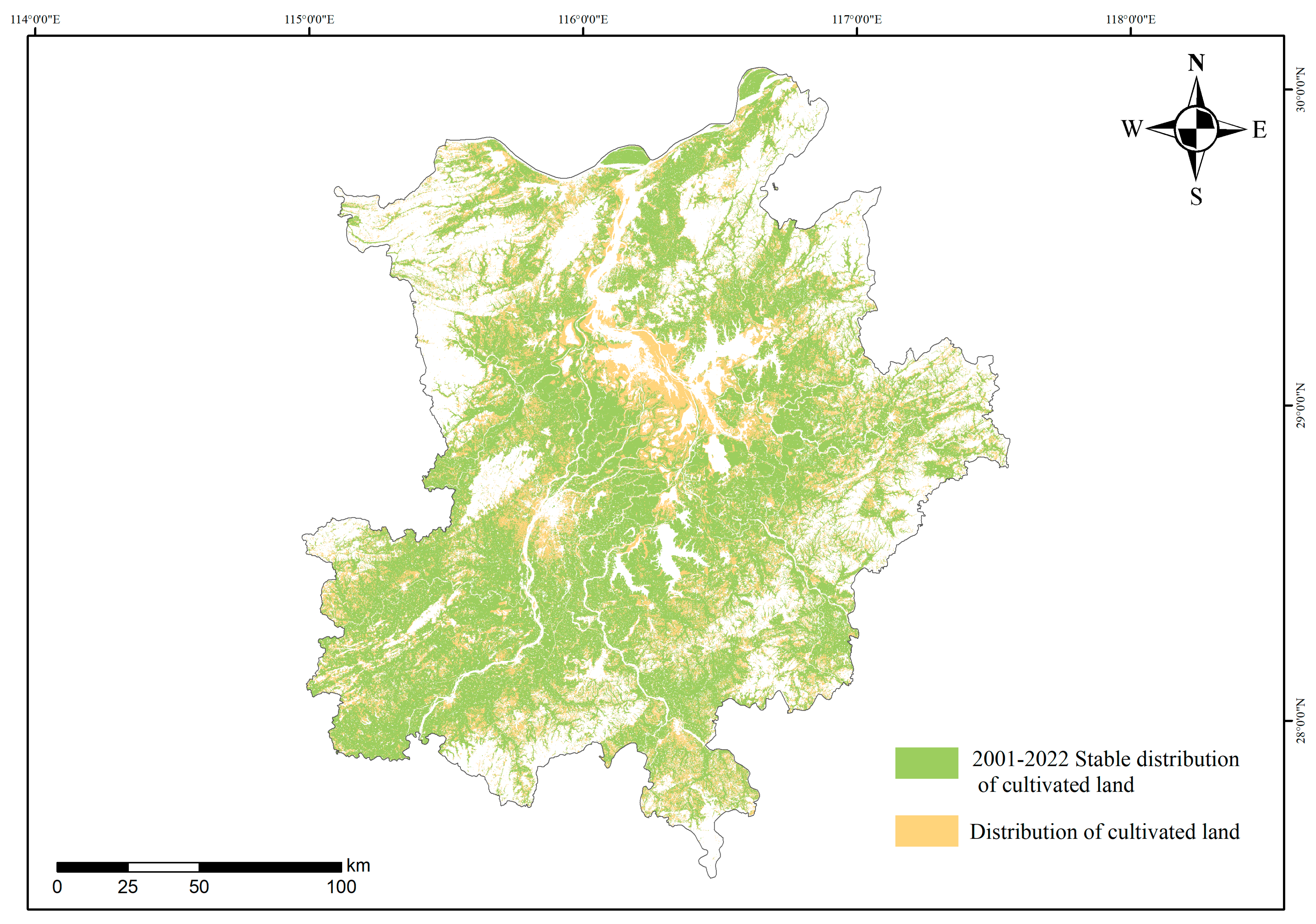
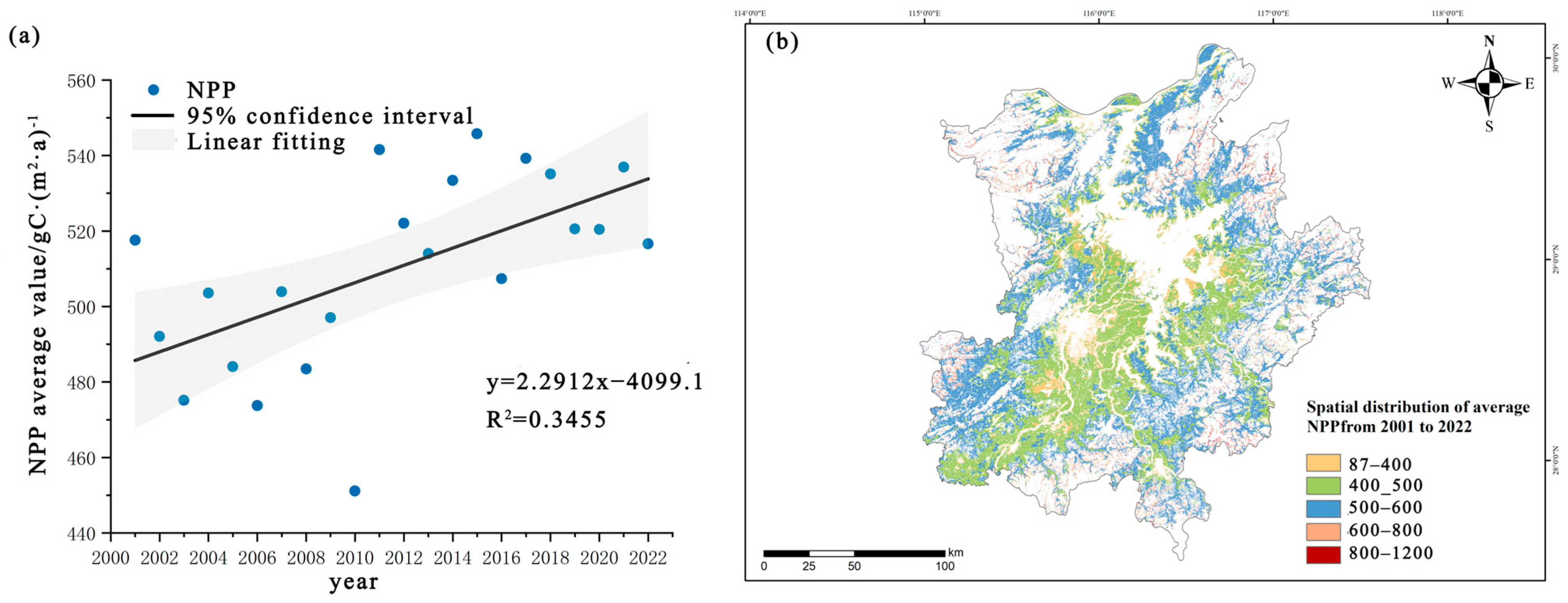
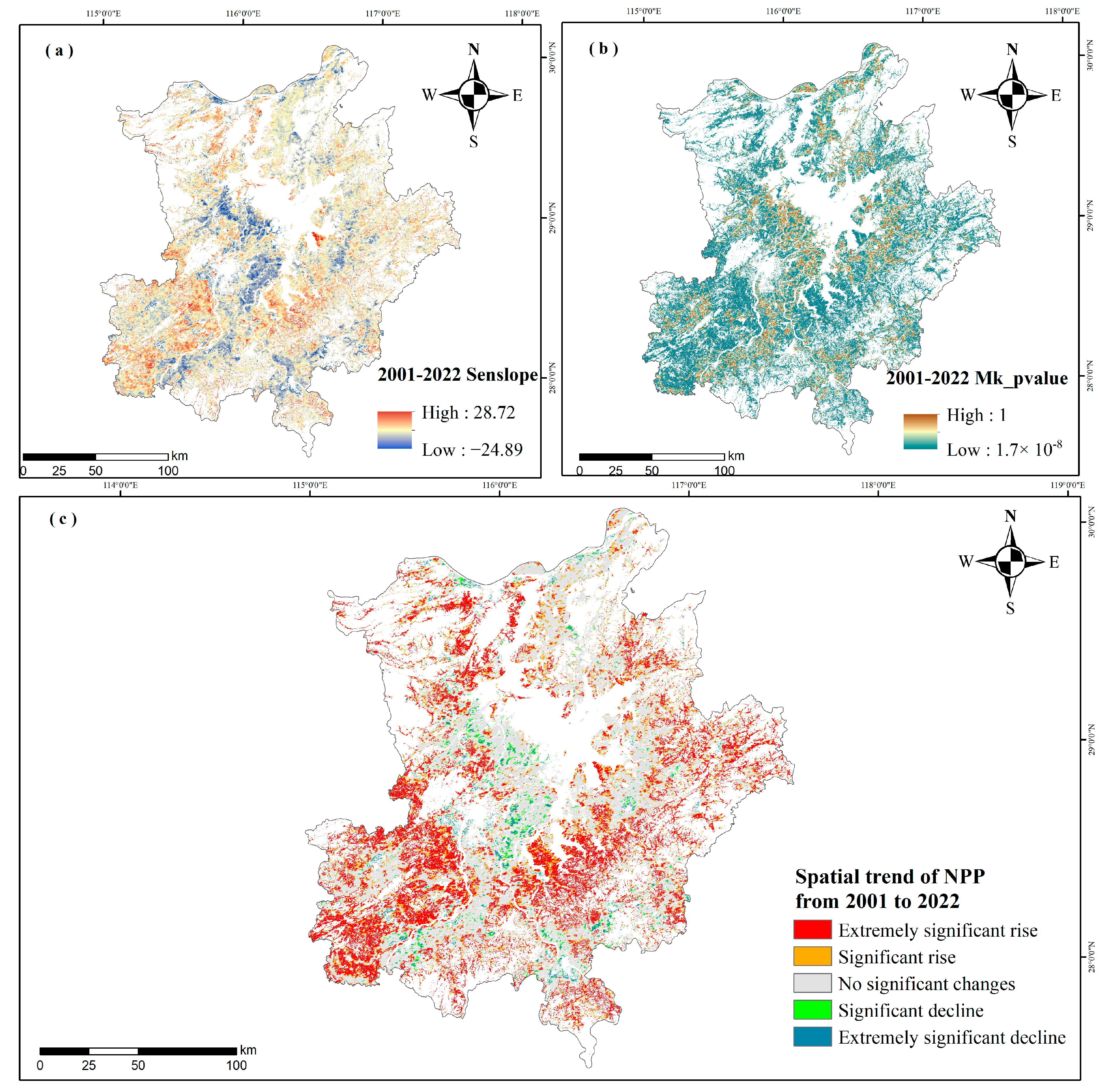
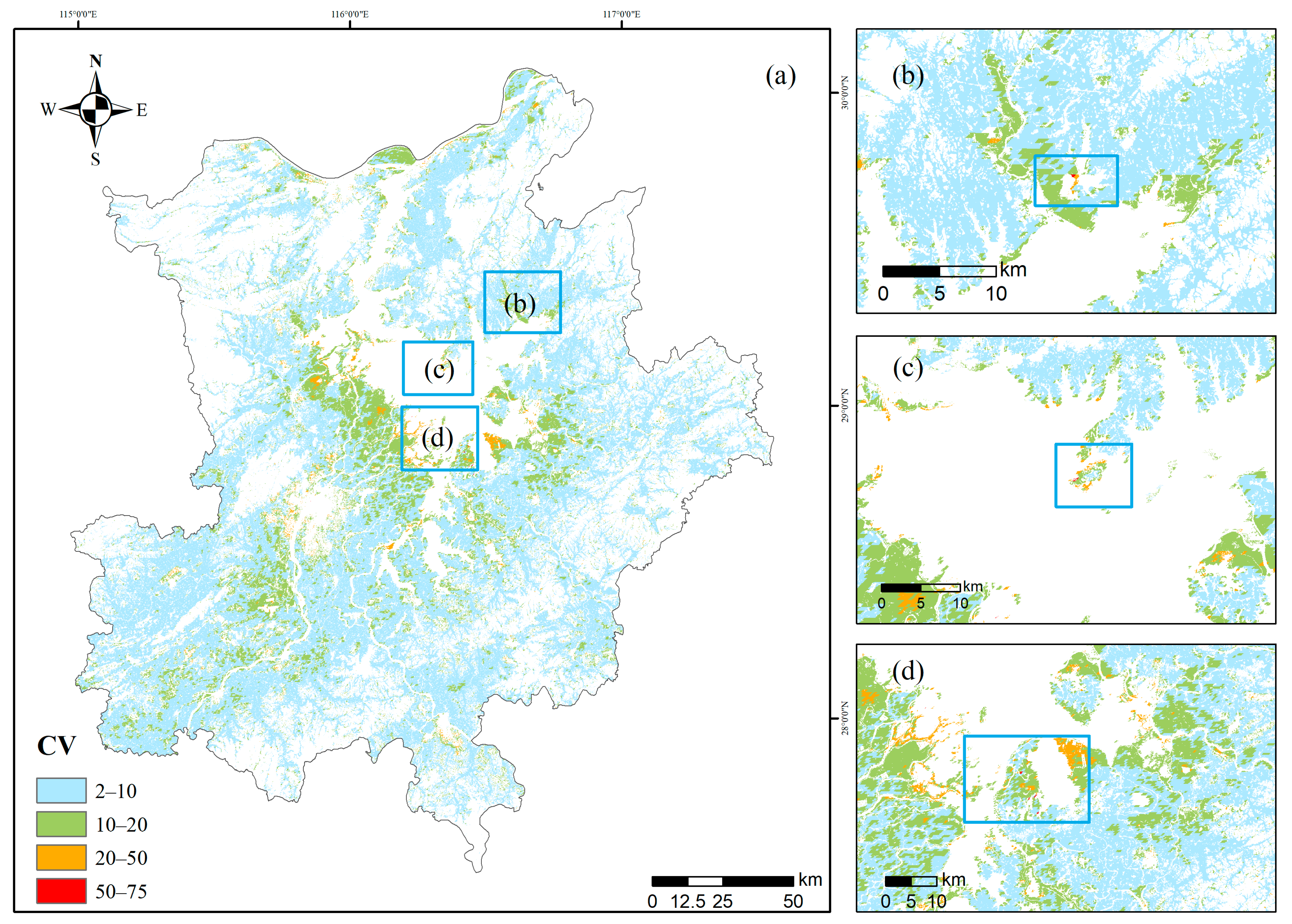


| Non-Standardized Coefficient | Standardization Coefficient | Significance | Collinearity Statistics | ||
|---|---|---|---|---|---|
| B | Beta | Tolerance | VIF | ||
| Constant | −811.789 | 0 | |||
| Field_road distance | −0.01 | −0.183 | 0.071 | 0.551 | 1.816 |
| Field_river distance | 0.02 | 0.691 | 0 | 0.62 | 1.612 |
| AREA_MN | 1.66 × 10−6 | 0.218 | 0.018 | 0.725 | 1.379 |
| FRACT | 793.149 | 0.481 | 0 | 0.451 | 2.219 |
| ENN | −0.246 | −0.706 | 0.001 | 0.18 | 5.558 |
| MAT | 0.324 | 0.077 | 0.734 | 0.101 | 9.93 |
| MAP | −0.006 | −0.371 | 0.037 | 0.186 | 5.384 |
Disclaimer/Publisher’s Note: The statements, opinions and data contained in all publications are solely those of the individual author(s) and contributor(s) and not of MDPI and/or the editor(s). MDPI and/or the editor(s) disclaim responsibility for any injury to people or property resulting from any ideas, methods, instructions or products referred to in the content. |
© 2025 by the authors. Licensee MDPI, Basel, Switzerland. This article is an open access article distributed under the terms and conditions of the Creative Commons Attribution (CC BY) license (https://creativecommons.org/licenses/by/4.0/).
Share and Cite
Yu, Z.; Ye, Y.; Jiang, Y.; Liu, Y.; Liao, Y.; Li, W.; Kuang, L.; Guo, X. Analysis of Cultivated Land Productivity in Southern China: Stability and Drivers. Land 2025, 14, 708. https://doi.org/10.3390/land14040708
Yu Z, Ye Y, Jiang Y, Liu Y, Liao Y, Li W, Kuang L, Guo X. Analysis of Cultivated Land Productivity in Southern China: Stability and Drivers. Land. 2025; 14(4):708. https://doi.org/10.3390/land14040708
Chicago/Turabian StyleYu, Zhihong, Yingcong Ye, Yefeng Jiang, Yuqing Liu, Yanqing Liao, Weifeng Li, Lihua Kuang, and Xi Guo. 2025. "Analysis of Cultivated Land Productivity in Southern China: Stability and Drivers" Land 14, no. 4: 708. https://doi.org/10.3390/land14040708
APA StyleYu, Z., Ye, Y., Jiang, Y., Liu, Y., Liao, Y., Li, W., Kuang, L., & Guo, X. (2025). Analysis of Cultivated Land Productivity in Southern China: Stability and Drivers. Land, 14(4), 708. https://doi.org/10.3390/land14040708






